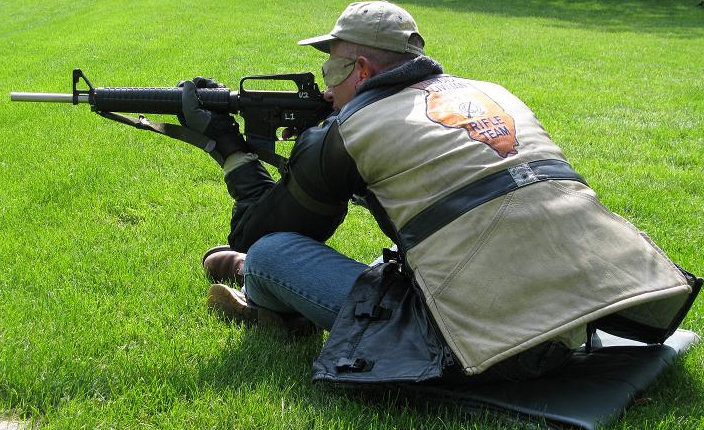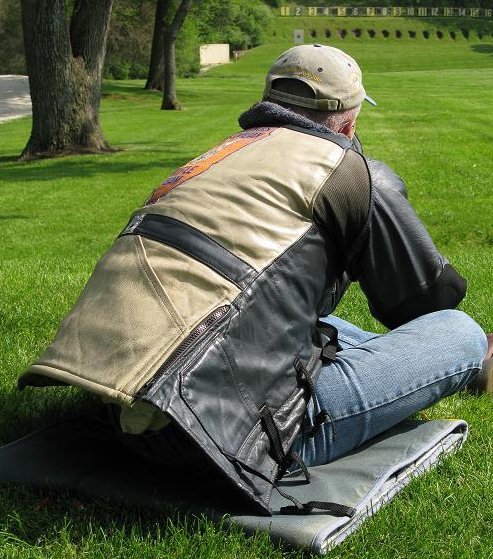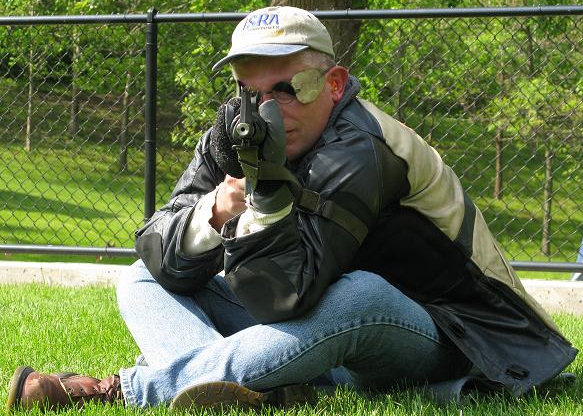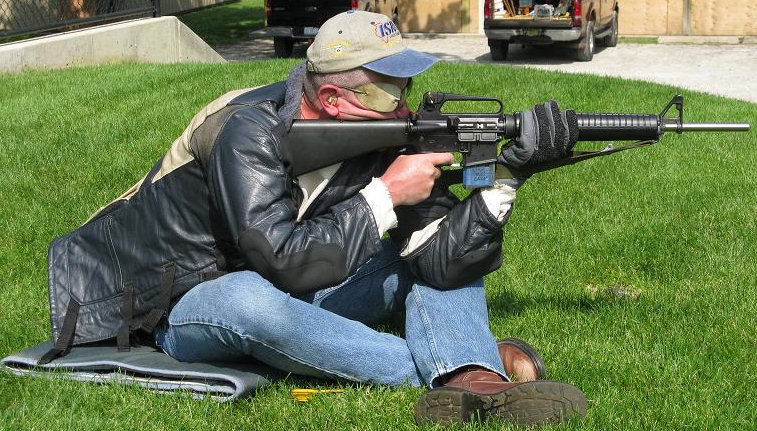Sitting
200 yard rapid fire is probably the most physical stage of the highpower course. While the other stages call for calm concentration, relaxed muscles, or simple front sight focus, rapid fire sitting brings you in more of a physical relationship with the rifle. In this match there is more pulling, grabbing, tugging, and forcing.
The stronger physical aspects may seem counter to what is normally taught regarding marksmanship, but the fundamentals of aligning the sights with the target and shooting the rifle are still there. They're just supplemented with a more forceful approach to get better control of the rifle in the limited time period required. My approach to the sitting position does not allow the rifle to be simply supported from below. There is more to it than that.
Refer to the pictures below as you read the position descriptions.




Foot Position
When I started shooting highpower my basic position followed the cross-legged (or Indian-style) position. This meant that my legs were crossed directly in front of me and my heels were relatively close to my body. This felt natural and I felt that it worked fine for several years as I was improving. Once I got to a point where I was expecting to clean the target I started looking at where I could improve and what I was seeing through the sights. Just sitting in position I saw that sometimes there would be a severe bounce as my heart pumped blood through my body. The extremes of the bounce would be about the height of the aiming black. This meant that I would have to time my shot as the sights bounced past the 10-ring. This was not good enough as I was relying too much on trigger timing to break shots in the middle.
After some experimentation I found a way to minimize the bounce that I was getting. I extended my feet from near my body to a position where my ankles were crossed ahead of my knees. My left lower leg is on top of my right ankle and my left elbow comes down on the bony part of my leg below the knee.
Forward Hand
My left hand has a full finger glove. To get the rifle elevated, my hand is positioned pretty far back on the handguard. There is only a couple of inches between my glove and the receiver. If my hand is further forward then the muzzle drops considerably. This problem can only be solved partially by tightening the sling. With the sling tighter the rifle follows the sling tension and is pulled to the left. I have found it easier to hold the rifle further back to bring the sights up to the target. This is certainly easier with the AR than the M1A.
I have tried different levels of grip with the forward hand. Everything from letting the rifle just rest in a cradle formed by my fingers to a tight grip around the handguard. Neither extreme seemed to work but I have settled on something closer to the tighter end of the scale. Just enough grip to hold the rifle but I also try to limit the sympathetic tension in my left upper arm.
Trigger Hand
The right hand has several jobs to do during the string. It actuates the trigger and extends forward to hit the magazine release while also controlling the rifle with a strong hold on the pistol grip. I have learned to not be afraid of forcefully holding the pistol grip. Not only is my entire hand squeezing it, but I am also exerting rearward pressure to pull the rifle back into my shoulder. My index finger is placed far into the trigger guard so that the tip of my finger is actually pointing back towards me. At the magazine change my trigger finger just extends straight out forward to press the magazine release.
Further down my right elbow is on the inside of my right knee. There is nothing supporting my right leg so I can't put too much force on this part of my position. Almost the entire weight of the rifle and upper body is supported by that forward elbow on top of the left leg.
Buttstock Placement
This is an aspect of the position that I ignored for too long. I would throw the butt into my shoulder in a random fashion without thinking how it was affecting my groups. I discovered that it was better to place the butt higher in my shoulder. This allowed me to place greater force down onto the stock from my head. My cheekbone is sitting on top of the stock and pushing down. The friction of the buttplate against my coat counteracts this and works to keep the rear of the rifle controlled in a vertical direction. My forward hand underneath the handguard and the grip from the fingers do the same thing at the front.
Once the position is established it's just a matter of maintaining control during the string. As I am shooting the sights should only need minor adjustment as I come back out of recoil. After each shot the rifle will come back to the target and there is minimal dressing up before the next shot is gone.
Front sight focus isn't as critical as it is for 300 & 600. It's more important to squeeze the shot when the post is in the middle of the target. That smooth squeeze is aided by the right hand grip and some concentration on the task at hand.
Most of the time the group on the target is better than what I see through the sights. It's pretty easy to see the bad shots in sitting but for me it's harder to see the good shots. A lot of shots that I may call as mid-ring 10's turn out to be X's and none of the 8, 9 or 10 x cleans that I have shot would have been called that way. During the string I just have to trust my position and ability to squeeze the shot off to get an acceptable result.